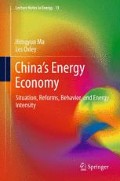Abstract
This chapter will present estimates from a translog cost function for both the aggregate economy and industrial economy using the methodologies presented in Chap. 4 and the data described in Chap. 5. The estimated elasticities include the substitution of and demand for energy. We will first discuss the estimated results for the aggregate economy followed by results for the regional aggregate economy and national industrial economy. We will then consider the resulting policy implications of the results and finally a conclusion for this chapter.
Access this chapter
Tax calculation will be finalised at checkout
Purchases are for personal use only
Notes
- 1.
There may be a double counting problem since much of the coal consumed in China is used to generate electricity. However, any double counting problem will become less serious over time because large industrial plants increasingly use more electricity from the outside network with coal used only for their boilers. As for power plants, they mainly use coal to generate electricity and use minimal electricity for their own consumption. We thank the referee for pointing out this issue.
- 2.
Empirically, Gross Domestic Products (GDP) has four components: compensation of employees, depreciation of fixed assets, net tax on production and operating surplus, which account for 40–50%, 13–15%, 13–15% and 20% of GDP, respectively, from 1996 to 2006 for China. The compensation of employees accounts for more than 70% of GDP. This means China invests more and consumes less, while USA consumes more and invests less in terms of GDP composition.
- 3.
One might expect energy and capital to be complements. However, the empirical literature finds evidence both ways. Berndt and Wood (1975), Fuss (1977), and Magnus (1979) find energy and capital to be strong complements. Halvorsen and Ford (1978) and Fuss and Waverman (1975) find ‘mixed results’ on energy-capital substitutability. Griffin and Gregory (1976) find strong evidence of capital-energy substitutability as does Pindyck (1979).
- 4.
For industrial economy, we aggregate gasoline and diesel into oil because both of their consumptions are very small.
References
Berndt ER, Wood DO (1975) Technology, prices, and derived demand for energy. Rev Econ Stat 57:259–268
Caloghirou YD, Mourelatos AG, Thompson H (1997) Industrial energy substitution during the 1990s in the Greek economy. Energ Econ 19:476–491
CESY [China Energy Statistical Yearbook] (1996–2007) China Statistical Publisher, Beijing
Cho WG, Nam K, Pagan JA (2004) Economic growth and interfactor/interfuel substitution in Korea. Energ Econ 26:31–50
Christopoulos DK, Tsionas EG (2002) Allocative inefficiency and the capital-energy controversy. Energ Econ 24:305–318
Fuss MA (1977) The demand for energy in Canadian manufacturing. J Econom 5:89–116
Fuss MA, Waverman L (1975) The demand for energy in Canada. Working paper, Institute for Policy Analysis, University of Toronto, Toronto
Griffin JM, Gregory PR (1976) An intercountry translog model of energy substitution responses. Am Econ Rev 66:845–857
Halvorsen R, Ford J (1978) Substitution among energy, capital and labor inputs in U.S. manufacturing, in capital and labor inputs in U.S. manufacturing. In: Pindyck RS (ed) Advances in the economics of energy and resources, vol 1. Jai Press, Greenwich
Hogan WW, Manne AS (1977) Energy-economy interactions: the fable of the elephant and the rabbit? Working EMF no. 1.3, Energy Modeling Forum, Stanford University, Palo Alto
Liao H, Fan Y, Wei Y (2007) What induced China’s energy intensity to fluctuate: 1997–2006? Energ Policy 35:4640–4649
Magnus JR (1979) Substitution between energy and non energy inputs in the Netherlands: 1950–1976. Int Econ Rev 20:465–484
Pindyck RS (1979) Interfuel substitution and the industrial demand for energy: an international comparison. Rev Econ Stat 61:169–179
Smyth R, Narayan PK, Shi H (2011) Substitution between energy and classical factor inputs in the Chinese steel sector. Appl Energ 88:361–367
Vega-Cervera JA, Medina J (2000) Energy as a productive input: the underlying technology for Portugal and Spain. Energy 25:757–775
Welsch H, Ochsen C (2005) The determinants of aggregate energy use in West Germany: factor substitution, technological change and trade. Energ Econ 27:93–111
Author information
Authors and Affiliations
Corresponding author
Rights and permissions
Copyright information
© 2012 Springer-Verlag Berlin Heidelberg
About this chapter
Cite this chapter
Ma, H., Oxley, L. (2012). Factor Substitution and the Demand for Energy. In: China’s Energy Economy. Lecture Notes in Energy, vol 13. Springer, Berlin, Heidelberg. https://doi.org/10.1007/978-3-642-25887-9_7
Download citation
DOI: https://doi.org/10.1007/978-3-642-25887-9_7
Published:
Publisher Name: Springer, Berlin, Heidelberg
Print ISBN: 978-3-642-25886-2
Online ISBN: 978-3-642-25887-9
eBook Packages: EngineeringEngineering (R0)

